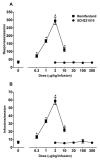Effects of the NOP agonist SCH221510 on producing and attenuating reinforcing effects as measured by drug self-administration in rats
- PMID: 25446568
- PMCID: PMC4259829
- DOI: 10.1016/j.ejphar.2014.10.029
Effects of the NOP agonist SCH221510 on producing and attenuating reinforcing effects as measured by drug self-administration in rats
Abstract
Nociceptin/orphanin FQ peptide (NOP) receptor agonists attenuate morphine-induced conditioned place preference in rodents. However, it is not known whether NOP agonists have reinforcing properties or can inhibit mu opioid receptor (MOP)-mediated reinforcement as measured by drug self-administration in rodents. Further understanding the behavioral effects of NOP agonists could suggest them as having potential in attenuating reinforcing effects of opioids. In the first part of the study, reinforcing properties of selective NOP agonist SCH221510 were determined and compared with the full MOP agonist remifentanil under fixed-ratio 5 (FR5) and progressive-ratio (PR) schedules of drug self-administration. In the second part, effects of systemic and intracisternal pretreatment of SCH221510 were determined and compared with MOP antagonist naltrexone in attenuating reinforcing effects of remifentanil and a non-drug reinforcer (sucrose pellets). Remifentanil self-administration (0.3-10 µg/kg/infusion) generated a biphasic dose-response curve, characteristic of drugs with reinforcing properties. SCH221510 (3-300 µg/kg/infusion) self-administration resulted in flat dose-response curves and early break-points under the PR, indicative of drugs lacking reinforcing value. Intracisternally, but not systemically, administered SCH221510 (0.3-3 µg) attenuated remifentanil self-administration, comparable with systemic naltrexone (0.03-0.3 mg/kg). SCH221510 (1-3 µg), unlike naltrexone (0.03-1 mg/kg), attenuated responding for sucrose pellets. Both effects of SCH221510 were reversed by the NOP antagonist J-113397 (0.3-3 µg). These results suggest that SCH221510 does not function as a reinforcer in rats, and that it can attenuate the reinforcing value of MOP agonists; therefore, the potential utility of NOP agonists for the treatment of drug addiction warrants further evaluation.
Keywords: Drug self-administration; NOP receptor; Nociceptin/orphanin FQ; Opioids; Remifentanil; SCH221510.
Copyright © 2014 Elsevier B.V. All rights reserved.
Figures






Similar articles
-
Effects of spinally administered bifunctional nociceptin/orphanin FQ peptide receptor/μ-opioid receptor ligands in mouse models of neuropathic and inflammatory pain.J Pharmacol Exp Ther. 2013 Jul;346(1):11-22. doi: 10.1124/jpet.113.203984. Epub 2013 May 7. J Pharmacol Exp Ther. 2013. PMID: 23652222 Free PMC article.
-
Nociceptin/orphanin FQ receptor activation attenuates antinociception induced by mixed nociceptin/orphanin FQ/mu-opioid receptor agonists.J Pharmacol Exp Ther. 2009 Dec;331(3):946-53. doi: 10.1124/jpet.109.156711. Epub 2009 Aug 27. J Pharmacol Exp Ther. 2009. PMID: 19713488 Free PMC article.
-
Roles of μ-opioid receptors and nociceptin/orphanin FQ peptide receptors in buprenorphine-induced physiological responses in primates.J Pharmacol Exp Ther. 2012 Oct;343(1):72-81. doi: 10.1124/jpet.112.194308. Epub 2012 Jun 28. J Pharmacol Exp Ther. 2012. PMID: 22743574 Free PMC article.
-
The biology of Nociceptin/Orphanin FQ (N/OFQ) related to obesity, stress, anxiety, mood, and drug dependence.Pharmacol Ther. 2014 Mar;141(3):283-99. doi: 10.1016/j.pharmthera.2013.10.011. Epub 2013 Nov 1. Pharmacol Ther. 2014. PMID: 24189487 Free PMC article. Review.
-
The nociceptin/orphanin FQ receptor (NOP) as a target for drug abuse medications.Curr Top Med Chem. 2011;11(9):1151-6. doi: 10.2174/156802611795371341. Curr Top Med Chem. 2011. PMID: 21050175 Free PMC article. Review.
Cited by
-
The Buprenorphine Analogue BU10119 Attenuates Drug-Primed and Stress-Induced Cocaine Reinstatement in Mice.J Pharmacol Exp Ther. 2021 Sep;378(3):287-299. doi: 10.1124/jpet.121.000524. Epub 2021 Jun 28. J Pharmacol Exp Ther. 2021. PMID: 34183434 Free PMC article.
-
Lack of effect of the nociceptin opioid peptide agonist Ro 64-6198 on pain-depressed behavior and heroin choice in rats.Drug Alcohol Depend. 2022 Feb 1;231:109255. doi: 10.1016/j.drugalcdep.2021.109255. Epub 2021 Dec 30. Drug Alcohol Depend. 2022. PMID: 34998256 Free PMC article.
-
Involvement of the nociceptin opioid peptide receptor in morphine-induced antinociception, tolerance and physical dependence in female mice.Metab Brain Dis. 2021 Dec;36(8):2243-2253. doi: 10.1007/s11011-021-00783-8. Epub 2021 Sep 16. Metab Brain Dis. 2021. PMID: 34529220
-
Drug Addiction: Hyperkatifeia/Negative Reinforcement as a Framework for Medications Development.Pharmacol Rev. 2021 Jan;73(1):163-201. doi: 10.1124/pharmrev.120.000083. Pharmacol Rev. 2021. PMID: 33318153 Free PMC article. Review.
-
Effects of NOP-Related Ligands in Nonhuman Primates.Handb Exp Pharmacol. 2019;254:323-343. doi: 10.1007/164_2019_211. Handb Exp Pharmacol. 2019. PMID: 30879202 Free PMC article.
References
-
- Bardo MT, Bevins RA. Conditioned place preference: what does it add to our preclinical understanding of drug reward? Psychopharmacology (Berl) 2000;153:31–43. - PubMed
-
- Baylon GJ, Kaplan HL, Somer G, Busto UE, Sellers EM. Comparative abuse liability of intravenously administered remifentanil and fentanyl. J Clin Psychopharmacol. 2000;20:597–606. - PubMed
Publication types
MeSH terms
Substances
Grants and funding
LinkOut - more resources
Full Text Sources
Other Literature Sources
Research Materials

